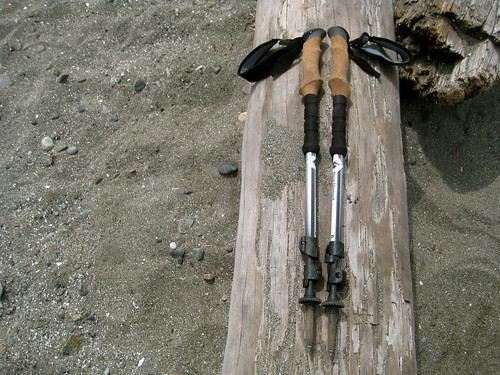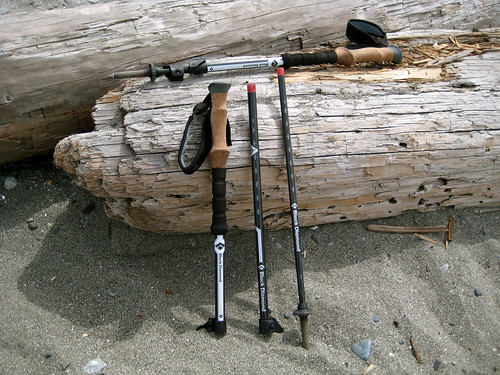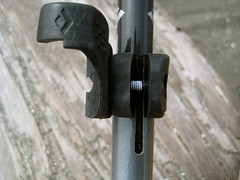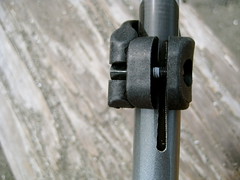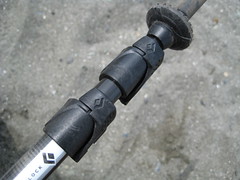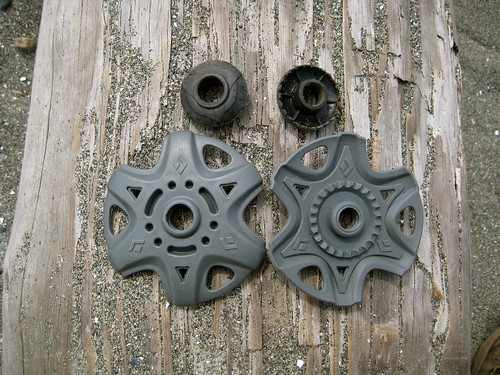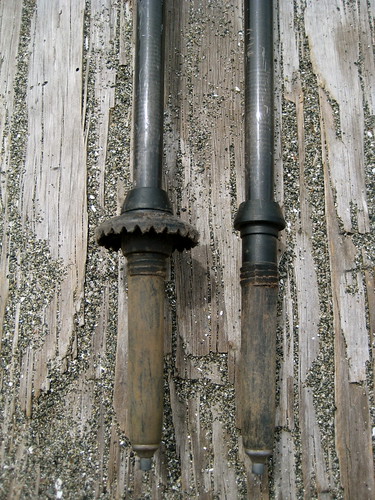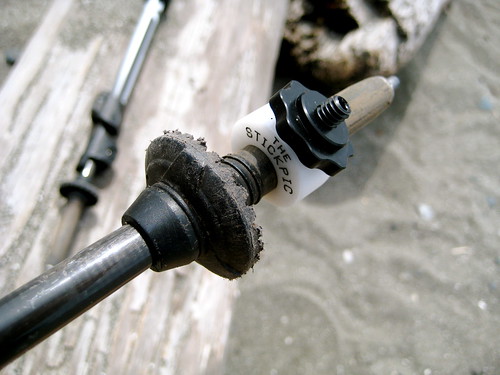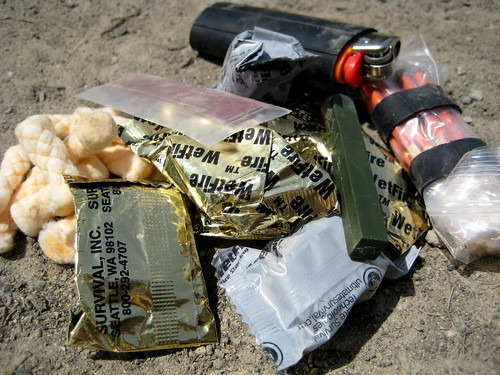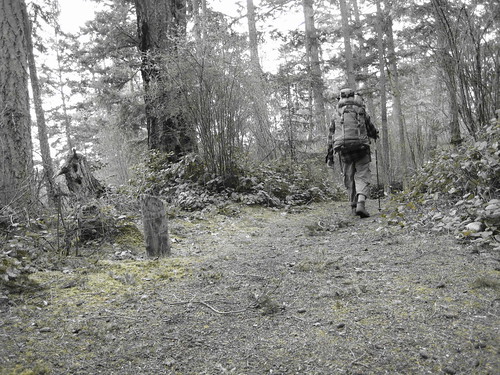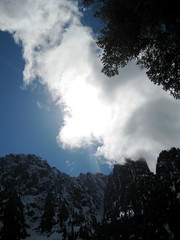Black Diamond Alpine Carbon Cork Trekking Poles
My last trekking poles were a pair of REI Peak UL Carbon Compacts. I was quite fond of them. At 11 oz for the pair, they were one of the lightest pair of telescoping poles available. Sadly, I broke them last January. A lot of folks who have only used aluminium poles cast a critical eye on those made of carbon fiber, thinking them flimsy and weak, so I think it is important to point out that it was a piece of the plastic locking mechanism that broke, not the carbon fiber pole shafts. I think that carbon fiber is a perfectly adequate material for trekking poles and should stand up to all reasonable abuse.
When my old poles broke, I took them into REI hoping that there might be some way to repair them. We spent an hour or so going through all their spare parts and trying to hack something usable back together, but in the end we couldn’t come to a solution that I was satisfied with. The fellow I’d been talking with mentioned that he could give me credit for the broken poles, which surprised me. I’ve returned plenty of used gear to REI, but never an item that was actually broken (and broken, as far as I’m concerned, due to user error and not any fault in the product itself). I guess they’re serious about that guarantee.
The credit was certainly welcome. I took it, but now I had to decide what to replace the poles with. REI no longer makes the Peak UL Carbon Compact trekking poles, so I couldn’t get another pair of the same. I started to look around to see what was on the market. My first limiting factor in the search was that I needed telescoping poles. I use trekking poles to pitch my Kifaru Paratarp. For the tarp, the needed height of the rear pole is 26”. This rules out a lot of poles that only collapse to something closer to 30”, such as those from Titanium Goat and Gossamer Gear. The other big factor was weight. Ideally, I wished to stay as close as possible to the 11 oz weight of the old poles. A quick look around told me that I would have to come to terms with at least some weight gain, as there didn’t seem to be anything to compete with the weight of the Peak UL Carbon Compacts. Some poles weighed 20 oz or more for the pair, which was just ridiculous! Leki had a few poles in the 14-16 oz neighborhood. A decent weight, I thought, but none of the poles really jumped out at me.
Eventually I came upon the offerings from Black Diamond. Their poles use the FlickLock locking mechanism, which I had heard of before. It had always intrigued me but I’d been turned off by the extra weight associated with it. Most of the big names in trekking poles, like Leki and Komperdell use a twist-lock mechanism which, as anybody who has ever used such poles can attest, is finicky at best. 1
After a bit more research, I decided that the greater functionality of the FlickLock system would be worth the weight gain. I landed on the Black Diamond Alpine Carbon Cork trekking poles. At 17.5 oz they were a good deal heavier than my old poles, but I thought I would give them a chance.
As the name implies the Alpine Carbon Cork poles have a cork handle and three shafts made of carbon fiber. They collapse down to 25” and expand to 51”.
FlickLock
The FlickLock mechanism operates as basically a clamp. When shut, it compresses the outer shaft, which prevents the inner shaft from moving. The tightness of the clamp can be adjusted with a single screw. It is simple, effective, and works in all conditions. There is no messing around with twisting one shaft to expand some little doohickey that you can’t see in the hopes that pressure will be built up against the inside of the outer shaft, no sitting around twisting one pole in the proper direction for 5 minutes wondering if the thing will ever lock, and there is little chance that shafts will accidentally collapse while in use. 2 Beyond the fact that the FlickLock mechanism actually works on a reliable basis, the next advantage is the speed of use: flick it open, adjust, and flick it closed. The main idea behind adjustable poles is that you can alter the length to meet the terrain: make the poles shorter for going uphill, longer for going downhill. With my previous twist-lock poles, I never did this. I only set the length once before setting out for the day. Periodically adjusting the poles was too risky (there was a likely chance I’d unlock them to adjust and spend countless minutes trying to get them to lock again) and even if I could be assured that the locking mechanism would work it still took a few seconds longer than I liked. Now with the FlickLock poles, I find myself merrily adjusting the poles to suit the terrain all day.
Baskets
As with any decent trekking poles, the Alpine Carbon Corks come with both dirt and snow baskets. The snow baskets are nothing special, but I was surprised at how small the dirt baskets were. I’m not sure why they chose to make the baskets with so small a diameter. So far I have no noticed no difference in how they work. I’m probably not the best judge of that though, as I find all kinds of baskets to be unnecessary when there isn’t any snow. (I had a habit of losing baskets with all my old poles, but since I noticed no difference without the baskets I never spent the money to replace them.)
Rather than just sliding on the pole and being secured with a nipple and indentation, the baskets on the Black Diamond poles are actually threaded. You slide them on and then screw them down over the threaded area. This seems like a much more secure system. I think it unlikely that I’ll inadvertently loose these baskets.
Handles
The cork handles on these poles are new to me. My previous poles have always had foam handles. I’ve heard claims that cork handles are more comfortable than foam, but so far I have noticed no difference in that department. Still, I have only had these poles for the cooler part of the year. Perhaps in the summer heat with sweaty palms I will appreciate more of a difference. I am curious to see if there is much difference in the durability of the cork. I’ve already had a couple small pieces chip off – not enough to raise too much concern, but I’ll keep an eye on it.
The ergonomic shape of the handle is fine, but I don’t use it much. Rather than grasping the poles properly, my preferred method of use for trekking poles has always been to rest my wrist in the strap and lightly hold the lower part of the handle in the fleshy part of my hand between thumb and forefinger. I don’t think this is the most efficient way of doing things – placing all the weight on the wrist doesn’t seem the best thing to do – but it has always been most comfortable and natural to me. It allows me to freely swing the pole back and forth as I walk without much movement of the arm. (I say pole, not poles because though I always carry two to setup my tarp, I rarely hike with more than one pole. I like to have one hand free and find two poles cumbersome and unnecessary except for going down the steepest of hills.)
Below the cork handle, the upper part of the shaft has a foam grip, which I appreciate it. My old REI UL Carbon Compact poles lacked this (because of the extra weight it would entail, no doubt) and I found that I missed the feature. It’s nice to have a comfortable spot to grip when you are climbing up a short steep hill and don’t want to adjust the length of the poles.
StickPic
Of course, with a new pair of poles I needed a new StickPic. My old models wouldn’t fit on the tip of the Black Diamond Alpine Carbon Corks. I tried to buy a new one, but Rodney Java refunded my money. That’s three now he’s given me for free. Someday I’ll track him down and shove the money under his door.
Impressions
I’ve been using the Black Diamond Alpine Carbon Cork for about 4 months now and they have exceeded my expectations. I was wary at first about not getting a return for the significant increase in weight. Of course I still would like them to be lighter, but I feel that the increased functionality has justified the increased weight. 3 I am very pleased with the poles.
Notes
- ↵ I had heard that Leki would be releasing a line of poles this spring using a new external locking mechanism similar to Black Diamond's FlickLock. They since have, and call it the SpeedLock, but this was back in winter and I couldn't wait the few months till the release. I haven't seen the new SpeedLock in person yet. It sounds like a good replacement of the old twist-lock system, but I'm not sure how it stacks up against Black Diamond's FlickLock. The closest Leki poles to compare with the Black Diamond Alpine Carbon Corks seem to be the Corklite Aergons.
- ↵ Ok, ok, the twist-lock isn't really that bad. It works most of the time -- but we're talking like 75% of the time, not 99%. Sometimes it made me want to beat the poles against a tree.
- ↵ The weight I gave for the poles includes the straps and dirt baskets. The straps weigh about 1 oz and the dirt baskets 0.3 oz, so a bit of weight could be saved by ditching those.
